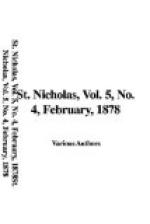The reader may think that the collections made by the dust-man are valueless, but such is not the case.
There are more than 300,000 inhabited houses in London, consuming more than 3,500,000 tons of coal a year, and besides the ashes from this great quantity of fuel, the dust-man gathers the other refuse of the houses. He is employed by a contractor, who agrees with the corporation to remove the ashes, etc., out of the city, and the contractor divides every load into six parts, as follows: Soil, or fine dust, which is sold to brick-makers for making bricks and to farmers for manure; brieze, or cinders, sold to brick-makers for burning brick; rags, bones and old metals, sold to marine-store dealers; old tin and iron vessels, sold to trunk-makers for clamps; bricks, oyster and other shells, sold for foundations and road-building; and old boots and shoes, sold to the manufacturers of Prussian blue.
Sometimes, much more valuable things than these are found, and the reader may remember the romance that Charles Dickens made out of a London dust-man—“Our Mutual Friend.”
It is in sifting the different parts of a load that the men, women and children, are employed; they are as busy as ants; mere babies and wrinkled old dames take a part in the labor, and all of them are so covered with dust and ashes that they are anything but pleasant to contemplate, though, as a rule, they are useful, honest, and industrious members of society.
“Dustie” is what the Londoners familiarly call the dust-man, and only a few know in what ignorance and poverty he lives. One would think that he would work himself into a better occupation, but his family have been dust-men for generations, and the generations after him are not likely to change.
HUCKLEBERRY.
BY FRANK R. STOCKTON.
More than a hundred and sixty-eight years ago, there lived a curious personage called “Old Riddler.” His real name was unknown to the people in that part of the country where he dwelt; but this made no difference, for the name given to him was probably just as good as his own. Indeed, I am quite sure that it was better, for it meant something, and very few people have names that mean anything.
He was called Old Riddler for two reasons. In the first place, he was an elderly man; secondly, he was the greatest fellow to ask riddles that you ever heard of. So, this name fitted him very well.
Old Riddler had some very peculiar characteristics,—among others, he was a gnome. Living underground for the greater part of his time, he had ample opportunities of working out curious and artful riddles, which he used to try on his fellow-gnomes; and if they liked them, he would go above-ground and propound his conundrums to the country people, who sometimes guessed them, but not often.
The fact is, that those persons who wished to be on good terms with the old gnome never guessed his riddles. They knew that they would please him better by giving them up.




